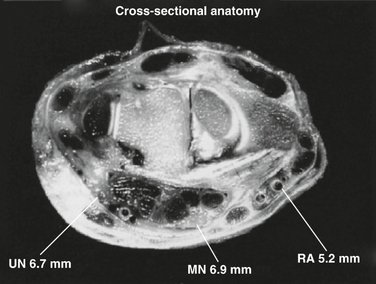CHAPTER 52 Arthroscopic Release of Wrist Contracture
Rationale and Basic Science Pertinent to the Procedure
In refractory cases, surgical intervention may be warranted given the effectiveness of the technique when used with other joints.1–5 Open and arthroscopic techniques have been described for the wrist, although there is a paucity of literature regarding clinical outcomes. Nonetheless, for cases where conservative management is inadequate, there seems to be a role for surgical management. In cases in which the source of the restriction in motion is the capsule, release or resection of the capsule would provide an increased range of motion, much as it does in other cases of arthrofibrosis.
Anatomy
Numerous nerves and blood vessels traverse the wrist joint. Their proximity is important in choosing arthroscopic portals and during release of contractures. The ulnar and median nerves and the radial artery are most at risk during this procedure, and their proximity to the capsule is relevant to the safety of the release (Fig. 52-1).
Ulnar Nerve
The ulnar nerve has two significant superficial branches, which originate approximately 10 cm proximal to the wrist joint—the dorsal cutaneous branch, and the volar cutaneous branches of the ulnar nerve. Placement of the 6R portal should be done using blunt dissection to avoid injury to the dorsal superficial ulnar cutaneous nerve. The portal should be placed in the proximal fifth (19%) of an imaginary line drawn from the ulnar styloid to the fourth web space.6
Median Nerve
The median nerve’s course on the central volar aspect of the wrist within the carpal tunnel places it away from the joint capsule. It is the most superficial structure within the carpal tunnel and sits 13 mm underneath the skin surface.7 It passes an average of 6.9 mm volar to the volar wrist capsule and at closest, 4 mm.8 The median nerve passes radially within the carpal tunnel and is, on average, 18 mm radial to the pisiform and 8 mm ulnar to the scaphoid tubercle. It is protected by the mass of the finger flexors during capsular excision.








